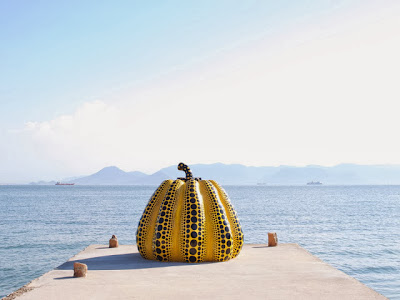Setouchi International Art Festival in Japan (http://setouchi-artfest.jp)
The Setouchi Triennale (also known as the Setouchi International Art Festival) is a contemporary art festival held every three years on a dozen islands in the Seto Inland Sea (Setonaikai), the sea which separates Honshu and Shikoku, two of Japan's main islands. It was first held in 2010.
Contemporary art has gained a prominent position in the region in recent decades thanks to various art projects by the Benesse Corporation on the island of Naoshima and more recently on the islands of Inujima and Teshima, all of which also serve as festival venues. The Setouchi Triennale is intended to further strengthen the region's position as a leading site for contemporary art and to spread the art to additional islands.
Like many rural parts of Japan, the islands in the Seto Inland Sea have been suffering from massive depopulation in recent decades, while their remaining residents have been aging at a rapid pace, causing a wide range of problems. One of the festival's main goals is to counteract these trends and revitalize the region in a sustainable and creative way by bringing contemporary art and tourism onto the islands.
Visitors to the region will be charmed not only by the intriguing art but also by the laid back, slow paced rural atmosphere of the islands' villages and the beauty of the island scenery. In many ways the festival resembles the Echigo-Tsumari Art Triennial, a similar art festival, which is held every three years in a rural mountainous area of Niigata Prefecture.
(Kusama.Y, Pumpkin)
During the festival, nearly 150 artworks by artists from Japan and overseas were exhibited on the twelve islands and around the ports of Takamatsu and Uno in addition to a considerable number of museums and art sites already in existence, including several permanent art installations from the 2010 festival. Much of the artwork will remain standing even after the end of the festival, justifying a visit to the area at any time of the year.
The artworks are found across the islands. Some of them stand outdoors in the fields, along the coast or in villages. Others make use of the numerous old homes which have been left abandoned due to the depopulation. The buildings are employed as exhibition spaces or have been converted into artworks themselves. In addition, there are the established museums and art sites on Naoshima, Inujima and Teshima islands.
(Chityu Museum)
I think this Setouchi International Art Festival could be said design activism, TED no.10 strategy. In fact, Setouchi International Art Festival 2010 brought about a beneficial economic effect on local economy. More specifically, according to the report of Kagawa prefecture in 2010, more than one million visitors came to Setouchi International Art Festival 2010 from home and abroad, and the festival brought more than 10 billion yen's economic effect. In this regard, the festival would be said one of the successful examples of local revitalization using art and design.
The most important influence of Setouchi International Art Festival I consider is that the festival has changed negative impression of islands, the festival's main venues. For instance, the small island of Oshima off the coast of Takamatsu serves as a treatment center and community for sufferers of Hansen's Disease. Because of this history, Oshima had been considered negative legacy by Japanese people, and no one felt to want to visit there. However, in a collaboration project between artists, hospitals and residents, an old dormitory was transformed into a fantastic art gallery. Nowadays many people have visited Oshima to see the gallery and art works. I believe that changing people's impression is extremely difficult, especially in case of bad impression. Although Ohima had negative impression from people due to Hansen's Disease, art and design have altered people's impression on Oshima.
 |
| Inujima |
Another example is Naoshima and Inujima which are used to be refineries. But most of refineries went bankrupt with the times. Now the Seirensho art project, built into the ruins of an old copper refinery in Inujima, is one of the festival's most noteworthy pieces. Eight smaller artworks can be found around the island's small village. And In the last few decades Naoshima has been transformed into an art island featuring the excellent Chichu Museum designed by Tadao Ando, Benesse Art House, Lee Ufan Museum and Art House Project. Actually I have been to Naoshima, when I was a university student in Japan. There were a significant number of art and design creations all over the island, however the creations coexisted with traditional culture of the island in harmony.
Setouchi International Art Festival has proved that art and design have profound influence on people. I think the festival is the one of the shapes of ideal relationship between art and design, and communal society as design activism.
References
・Art Setouchi (2013) [Internet]. Available from :<http://setouchi-artfest.jp> [Accessed 17 November 2013].
・Kitagawa. F, (2013) Evolution of Art, Tokyo: Bijyutsu shuppansha.










